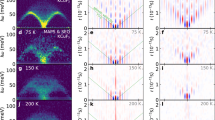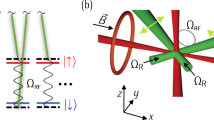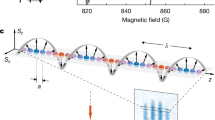Abstract
Discontinuous (first-order) quantum phase transitions and the associated metastability play central roles in diverse areas of physics, ranging from ferromagnetism to the false-vacuum decay in the early Universe1,2; yet, their dynamics are not well understood. Ultracold atoms provide an ideal platform for experimental simulations of quantum phase transitions3,4; so far, however, studies of first-order phase transitions have been limited to systems with weak interactions5,6,7,8, where quantum effects are exponentially suppressed. Here we realize a strongly correlated driven many-body system whose transition can be tuned from continuous to discontinuous. Resonant shaking of a one-dimensional optical lattice hybridizes the two lowest Bloch bands9,10, driving a novel transition from a Mott insulator to a superfluid with a staggered phase order. For weak shaking amplitudes, this transition is discontinuous and the system can remain frozen in a metastable state, whereas for strong shaking, it undergoes a continuous transition towards a superfluid. Our observations of this metastability and hysteresis agree with numerical simulations and pave the way for exploring the crucial role of quantum fluctuations in discontinuous transitions.
This is a preview of subscription content, access via your institution
Access options
Access Nature and 54 other Nature Portfolio journals
Get Nature+, our best-value online-access subscription
$29.99 / 30 days
cancel any time
Subscribe to this journal
Receive 12 print issues and online access
$209.00 per year
only $17.42 per issue
Buy this article
- Purchase on Springer Link
- Instant access to full article PDF
Prices may be subject to local taxes which are calculated during checkout




Similar content being viewed by others
Data availability
The data for all figures that support the findings of this study are available in Hierarchical Data Format (HDF5) at the Apollo repository (https://doi.org/10.17863/CAM.78025)
Code availability
The code that supports the plots in this paper is available from the corresponding author upon reasonable request.
References
Coleman, S. Fate of the false vacuum: semiclassical theory. Phys. Rev. D 15, 2929 (1977).
Vilenkin, A. Birth of inflationary universes. Phys. Rev. D 27, 2848 (1983).
Greiner, M. et al. Quantum phase transition from a superfluid to a Mott insulator in a gas of ultracold atoms. Nature 415, 39–44 (2002).
Gross, C. & Bloch, I. Quantum simulations with ultracold atoms in optical lattices. Science 357, 995–1001 (2017).
Struck, J. et al. Engineering Ising-XY spin-models in a triangular lattice using tunable artificial gauge fields. Nat. Phys. 9, 738–743 (2013).
Trenkwalder, A. et al. Quantum phase transitions with parity-symmetry breaking and hysteresis. Nat. Phys. 12, 826–829 (2016).
Campbell, D. et al. Magnetic phases of spin-1 spin–orbit-coupled Bose gases. Nat. Commun. 7, 10897 (2016).
Qiu, L.-Y. et al. Observation of generalized Kibble-Zurek mechanism across a first-order quantum phase transition in a spinor condensate. Sci. Adv. 6, eaba7292 (2020).
Sträter, C. & Eckardt, A. Orbital-driven melting of a bosonic Mott insulator in a shaken optical lattice. Phys. Rev. A 91, 053602 (2015).
Eckardt, A. Colloquium: atomic quantum gases in periodically driven optical lattices. Rev. Mod. Phys. 89, 011004 (2017).
Kibble, T. W. Some implications of a cosmological phase transition. Phys. Rep. 67, 183–199 (1980).
McLerran, L. The physics of the quark-gluon plasma. Rev. Mod. Phys. 58, 1021 (1986).
Sachdev, S. Quantum Phase Transitions 2nd edn (Cambridge Univ. Press, 2011).
Lifshitz, I. M. & Kagan, Y. Quantum kinetics of phase transitions at temperatures close to absolute zero. Sov. J. Exp. Theor. Phys. 35, 206–214 (1972).
Fialko, O. et al. Fate of the false vacuum: towards realization with ultra-cold atoms. EPL 110, 56001 (2015).
Fialko, O. et al. The universe on a table top: engineering quantum decay of a relativistic scalar field from a metastable vacuum. J. Phys. B: At. Mol. Opt. Phys. 50, 024003 (2017).
Ng, K. L. et al. Fate of the false vacuum: finite temperature, entropy, and topological phase in quantum simulations of the early Universe. PRX Quantum 2, 010350 (2021).
Owerre, S. & Paranjape, M. Macroscopic quantum tunneling and quantum–classical phase transitions of the escape rate in large spin systems. Phys. Rep. 546, 1–60 (2015).
Osterloh, A. et al. Scaling of entanglement close to a quantum phase transition. Nature 416, 608–610 (2002).
Cooper, N. R., Dalibard, J. & Spielman, I. B. Topological bands for ultracold atoms. Rev. Mod. Phys. 91, 015005 (2019).
Eckardt, A., Weiss, C. & Holthaus, M. Superfluid-insulator transition in a periodically driven optical lattice. Phys. Rev. Lett. 95, 260404 (2005).
Zenesini, A. et al. Coherent control of dressed matter waves. Phys. Rev. Lett. 102, 100403 (2009).
Michon, E. et al. Phase transition kinetics for a Bose Einstein condensate in a periodically driven band system. New J. Phys. 20, 053035 (2018).
Zheng, W. et al. Strong interaction effects and criticality of bosons in shaken optical lattices. Phys. Rev. Lett. 113, 155303 (2014).
Parker, C. V., Ha, L.-C. & Chin, C. Direct observation of effective ferromagnetic domains of cold atoms in a shaken optical lattice. Nat. Phys. 9, 769–774 (2013).
Lim, L.-K., Smith, C. M. & Hemmerich, A. Staggered-vortex superfluid of ultracold bosons in an optical lattice. Phys. Rev. Lett. 100, 130402 (2008).
Weinberg, M. et al. Multiphoton interband excitations of quantum gases in driven optical lattices. Phys. Rev. A 92, 043621 (2015).
Arimondo, E. et al. Kilohertz-driven Bose–Einstein condensates in optical lattices. Adv. At. Mol. Opt. Phys. 61, 515–547 (2012).
Schollwöck, U. The density-matrix renormalization group in the age of matrix product states. Ann. Phys. 326, 96–192 (2011).
Goldman, N. & Dalibard, J. Periodically driven quantum systems: effective Hamiltonians and engineered gauge fields. Phys. Rev. X 4, 031027 (2014).
Clark, L. W., Feng, L. & Chin, C. Universal space-time scaling symmetry in the dynamics of bosons across a quantum phase transition. Science 354, 606–610 (2016).
Shimizu, K. et al. Dynamics of first-order quantum phase transitions in extended Bose–Hubbard model: from density wave to superfluid and vice versa. New J. Phys. 20, 083006 (2018).
Pelissetto, A., Rossini, D. & Vicari, E. Out-of-equilibrium dynamics driven by localized time-dependent perturbations at quantum phase transitions. Phys. Rev. B 97, 094414 (2018).
Coulamy, I. B., Saguia, A. & Sarandy, M. S. Dynamics of the quantum search and quench-induced first-order phase transitions. Phys. Rev. E 95, 022127 (2017).
Amaricci, A. et al. First-order character and observable signatures of topological quantum phase transitions. Phys. Rev. Lett. 114, 185701 (2015).
Zhao, J., Zhang, Y. & Jain, J. Crystallization in the fractional quantum Hall regime induced by Landau-level mixing. Phys. Rev. Lett. 121, 116802 (2018).
Wu, K.-H. et al. Z2 topological order and first-order quantum phase transitions in systems with combinatorial gauge symmetry. Phys. Rev. B 104, 085145 (2021).
Paeckel, S. et al. Time-evolution methods for matrix-product states. Ann. Phys. 411, 167998 (2019).
Fölling, S. et al. Direct observation of second-order atom tunnelling. Nature 448, 1029–1032 (2007).
Drese, K. & Holthaus, M. Ultracold atoms in modulated standing light waves. Chem. Phys. 217, 201–219 (1997).
Ejima, S. et al. Characterization of Mott-insulating and superfluid phases in the one-dimensional Bose-Hubbard model. Phys. Rev. A 85, 053644 (2012).
Paeckel, S. et al. Time-evolution methods for matrix-product states. Ann. Phys. 411, 167998 (2019).
Rachel, S. et al. Detecting quantum critical points using bipartite fluctuations. Phys. Rev. Lett. 108, 116401 (2012).
Calabrese, P. & Cardy, J. Entanglement entropy and quantum field theory. J. Stat. Mech. 2004, P06002 (2004).
Acknowledgements
This work was partly funded by the European Commission ERC Starting Grant QUASICRYSTAL, the EPSRC Grant EP/R044627/1 and Programme Grant DesOEQ (EP/P009565/1), and by a Simons Investigator Award. We are grateful to E. Gottlob and A. Eckardt for fruitful discussions.
Author information
Authors and Affiliations
Contributions
N.C. and U.S. conceived and supervised the project, with S.D. and B.S. leading the detailed design. B.S., S.B., J.-C.Y. and E.C. performed the experiments. B.S. analysed the experimental data and S.D. performed the numerical simulations. All the authors contributed to the interpretation of the results and writing of the manuscript.
Corresponding author
Ethics declarations
Competing interests
The authors declare no competing interests.
Peer review
Peer review information
Nature Physics thanks the anonymous reviewers for their contribution to the peer review of this work.
Additional information
Publisher’s note Springer Nature remains neutral with regard to jurisdictional claims in published maps and institutional affiliations.
Extended data
Extended Data Fig. 1 Single-particle correlations.
a, Average correlations \(\langle \langle {\hat{a}}_{i}^{{\dagger} }{\hat{a}}_{i+r}\rangle \rangle\) and \(| \langle \langle {\hat{b}}_{i}^{{\dagger} }{\hat{b}}_{i+r}\rangle \rangle |\) in the ground state with L = 64 sites, fitted with an exponential times a power law. b-c, Correlation length (solid lines) and Luttinger parameter (dashed lines) extracted from the fits across first-order and continuous transitions denoted by vertical lines (cf. Extended Data Fig. 2).
Extended Data Fig. 2 Entanglement and central charge.
a, Von Neumann entanglement entropy across bipartitions of the ground state for L = 64 and \({{{\mathcal{A}}}}=3\) nm with different shaking frequencies, fitted with the conformal field theory (CFT) prediction in Eq. (10). b-f, Fitted central charge c as a function of the shaking frequency at increasing shaking amplitudes, exhibiting discontinuous jumps and smooth peaks characteristic of discontinuous (first-order) and continuous phase transitions, respectively (shown by the vertical dashed lines, with the same color convention as in the phase diagram in Supplementary Fig. S3).
Extended Data Fig. 3 Frequency modulation of lattice laser.
An example of the indirect sweep sequence with a final shaking frequency ff = 21 kHz and a final shaking amplitude \({{{\mathcal{A}}}}=1.9\)nm. a, b and c show variations of the modulation depth Al (the shaking amplitude \({{{\mathcal{A}}}}\)), the shaking frequency f and the laser frequency fl (the displacement of the lattice s), respectively.
Extended Data Fig. 4 Measured band-edge population after different sweep durations for different shaking amplitudes.
a and b show the final population \({{{{\mathcal{N}}}}}_{\pi }\) after direct sweeps in the forward (from a MI to a π-SF state) and backward (from a π-SF to a MI state) directions, respectively. We extract \(\partial {{{{\mathcal{N}}}}}_{\pi }/\partial \tau\) by the linear fits (solid lines). The fit results are shown in Fig. 4c,d.
Extended Data Fig. 5 The band-edge population \({{{{\mathcal{N}}}}}_{\pi }\).
(a) Atom numbers around k = 0 (n0) and k = ± k0 (nπ) are counted inside the boxes in blue and red, respectively. Note that nπ is the sum over the two red boxes. (b-f) are measured with different box sizes lbox/k0 = 0.1, 0.2, 0.4, 0.6, and 0.8, respectively.
Supplementary information
Supplementary Information
Supplementary Sections I–IV and Figs. 1–6.
Rights and permissions
About this article
Cite this article
Song, B., Dutta, S., Bhave, S. et al. Realizing discontinuous quantum phase transitions in a strongly correlated driven optical lattice. Nat. Phys. 18, 259–264 (2022). https://doi.org/10.1038/s41567-021-01476-w
Received:
Accepted:
Published:
Issue Date:
DOI: https://doi.org/10.1038/s41567-021-01476-w
This article is cited by
-
False vacuum decay via bubble formation in ferromagnetic superfluids
Nature Physics (2024)
-
A shaking phase transition
Nature Physics (2022)



